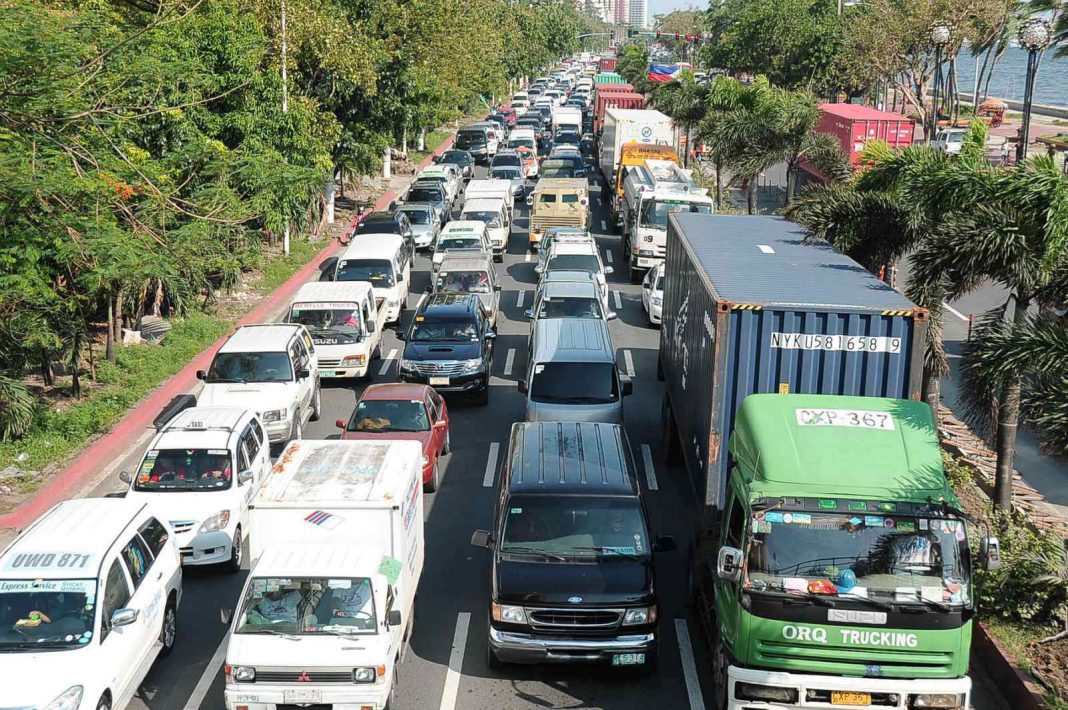In photo: Cargo trailers line up in the assigned lane going to Manila Port (Photo file from THEPHILBIZNEWS)
By Alithea De Jesus
As the Philippines gears up to welcome the new administration, transport and logistics experts and executives are hoping the incoming government will act on calls to strengthen coordination among relevant agencies and stakeholders in the transport sector, saying this will expedite cargo movement and help ease the traffic problem, especially in Metro Manila.
“The core issue is a lack of coordination and the problem is that we have 20 people trying to make a decision to make things more efficient, and that’s just not going to work,” said Christian Martin Gonzalez, executive vice president and chief risk officer of port operator International Container Terminal Services, Inc.
Gonzalez, who spoke at a recent webinar held by the Philippine Chamber of Commerce and Industry, said there are different rules applied in relation to truck routes, truck bans, and truck window hours, and these disjointed regulations add to the cargo delay.
Pierre Carlo Curay, president of the Supply Chain Management Association of the Philippines, agreed, noting how this lack of cohesiveness in policies has held average truck deliveries per day in Metro Manila to just 0.5% to 1%.
“Most of the time, transport is one of the industries [that are] being penalized by different policies that slow down traffic and increase cost. We have the truck ban, the single lane, the number coding scheme…. This is why the cost of deliveries is very high, and if the cost of transport is high, it just gets passed to us consumers,” he said.
Consequently, logistics cost to percentage of sales has ballooned to 25%, which Curay said meant that “it takes almost one-third of the cost of the product to get the product to you,” making logistics cost in the country among the highest in ASEAN. This also compares to the average logistics cost to percentage of sales of only 10% to 11% in developed countries.
Curay recommends finding ways to ensure unhampered movement of goods to boost economic progress. These include decongesting Metro Manila, continuing the Build, Build, Build infrastructure projects, and increasing focus on railway and integrating it into the logistics and supply chain infrastructure.
Gonzalez had similar suggestions, noting that for the short term, coordination efforts should focus on maximizing the use of the existing infrastructure, while at the same time the government should work on long-term solutions such as building purpose-built infrastructure to support cargo movement through the city.
Curay also suggests that the capacity of sea ports should be adjusted by spreading out the distribution of the containers to include Batangas and Subic.
He also stressed the need for a Supply Chain National Development Council to “allow us to have a private sector and government partnership that can push forward the supply chain agenda.” He said this will serve to “connect the different government agencies to work together alongside our private partners.”
Moreover, Curay batted for the removal of the truck ban and the color coding for trucks, noting such measures only pad logistics cost and lower Philippine competitiveness.
Curay also requests requiring nighttime deliveries to malls and retail stores to spread out deliveries beyond daytime.
Similarly, Gonzalez said that existing infrastructure needs to be utilized 24/7 to spread cargo load across the entire 24 hours and those night deliveries should be encouraged and weekend transactions with agencies allowed.
Curay also highlighted the importance of digitalizing the supply chain, commenting that manual operations create inefficiencies, errors, and slowdown of goods flow.
Gonzalez added that the use of appointment systems and other digital technologies is necessary to raise efficiencies, especially in moving empty containers, and also recommends removing impediments on key roads and infrastructure to clear the way for the transport of goods.
Curay said all these recommendations will help the country’s embattled supply chain and logistics sector, which continues to face several challenges brought about by a combination of the decades-long traffic problem and the more recent impacts of the pandemic and the Russia-Ukraine war.
Meantime, for Rene Santiago, former consultant on urban transport for the Japan International Cooperation Agency, the only solution for the never-ending traffic woes in the metropolis is to “decouple mobility from urban and income rise.”
“As the metropolis grows it attracts more employees, more workforce leads to more trips. With more trips you’ll have traffic congestion, so you try to address by putting more infrastructure investment…. This enhances the comparative advantage of Metro Manila compared to the other regions.”
To break this cycle, he said government ought to “decouple economic growth and growth of mobility” by accelerating the shift to the 4th Industrial Revolution work style, which adopts hybrid work and hybrid school and results in cutting down of land trips by the millions.














